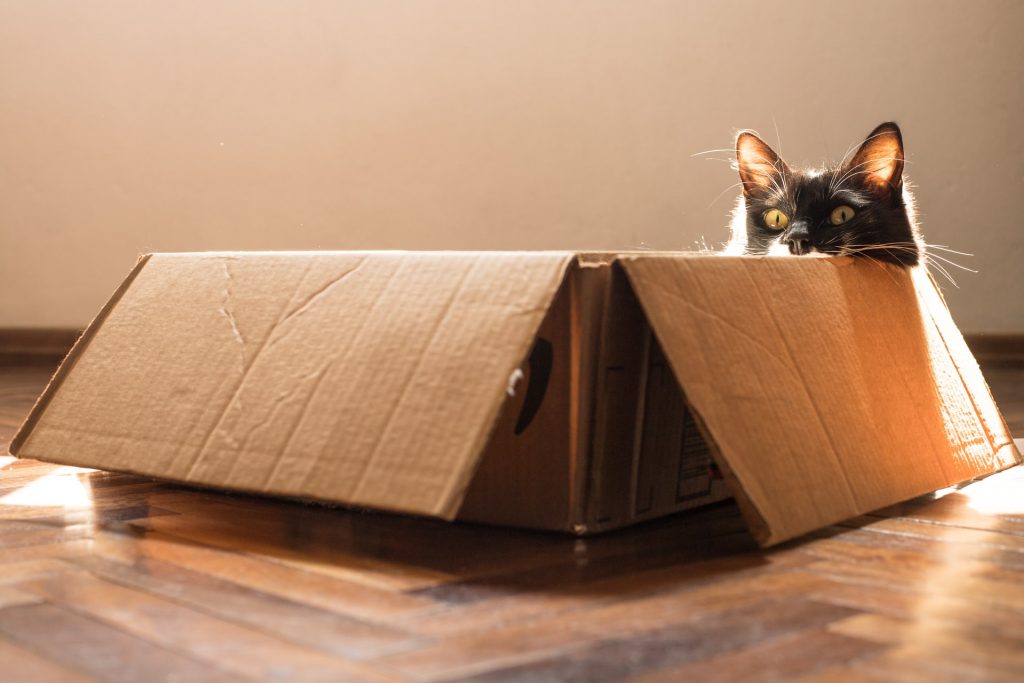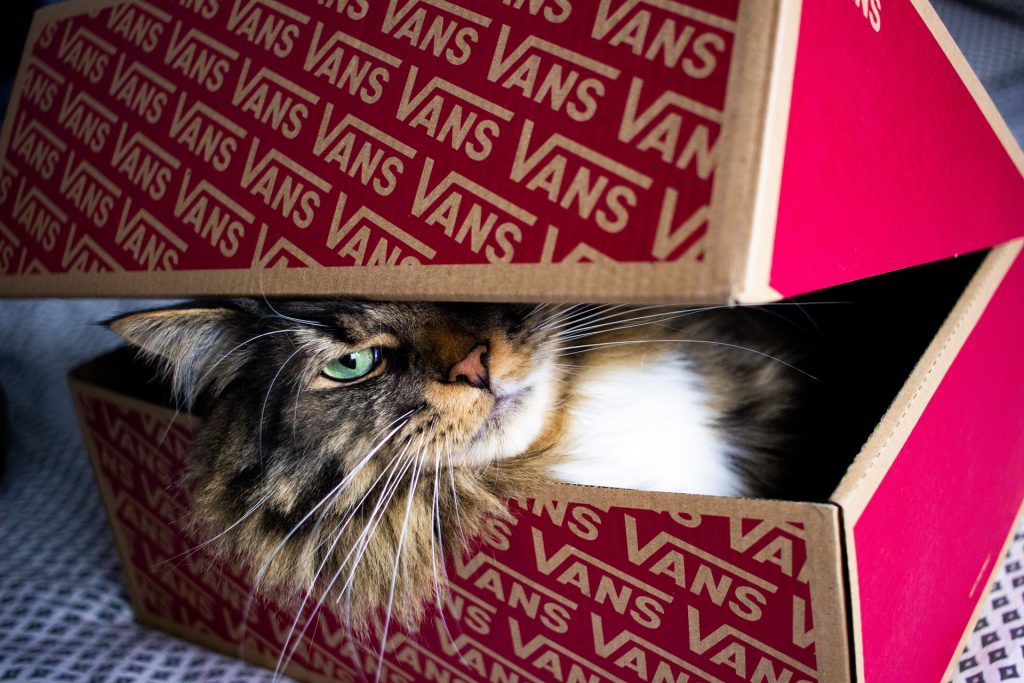The Enigma Behind Cats and their Love of Boxes
Australians certainly love their pets – the country has one of the highest rates of pet ownership globally. Over 60% of Australian households own a pet, and of these, more than one-quarter have a cat. (Source: RSPCA Australia) As their owners can certainly attest, felines make loving and entertaining pets, but they have a mysterious side to them. One big mystery surrounding cats is their uncanny love for boxes.
There are instinctual reasons why cats are drawn to boxes. By concealing themselves in boxes, cats can act out their natural hunting instinct. Cats find security hiding in boxes, which helps them cope with stress. Boxes also provide warm enclosures in which to nap, as well as sources of entertainment.
If you are looking for ways to entertain your feline companion or make them feel more comfortable in their surroundings, you may want to reconsider that trip to the pet store and just lay out a couple of empty boxes. Empty boxes are the perfect items to provide them with a sense of security, a way to cope with stress, and the perfect place to nap.

Why Do Cats Love Boxes So Much?
At first glance, it may appear that cats are playing hide-and-seek when they disappear into boxes. While it is true that hiding in boxes can occasionally be a form of feline entertainment, boxes serve far more important functions as far as the overall mental and physical well-being of cats is concerned. It is essential to remember that domesticated cats are descended from predators, and certain behaviors are instinctual.
As meopredators, cats are genetically programmed to hunt prey smaller than them while avoiding larger would-be predators. A cat‘s instincts, therefore, consist of hunting and stalking behaviors, along with seeking out shelter and security and avoiding being hunted themselves. (Source: Best Friends Animal Society)
Concealing Themselves in Boxes is a Natural Hunting Behavior for Cats
It is believed that cats were first domesticated in the Middle East roughly 10,000 years ago and were bred by the ancient Egyptians nearly 3,000 years ago. Although they have lived among humans and their homes for thousands of years, cats still have similar traits and exhibit the same instinctual behaviors as their ancestors that lived in the wild many centuries ago. (Source: International Cat Care)
Chief among these is the natural hunting instinct of house cats (scientific name Felis catus) even though they have not had to forage and hunt for food for millennia. Cats are naturally stalkers and ambush hunters, meaning that they hide from unsuspecting mice or other small animals, and they strike their prey from a concealed position.
So the next time you observe your cat shooting out from its cardboard box and pouncing on a toy mouse, you are witnessing your pet’s natural hunting instincts on full display. (Source: Meowingtons)
Hiding in Boxes Reduces Stress in Cats
One important aspect of the seemingly universal love of boxes among cats ties into their ability to adapt to new and unfamiliar environments. A fascinating report prepared by scientists in the Netherlands studied cats in Dutch animal shelters and observed the cats‘ stress levels during a two-week stay. Half of the cats were provided hiding boxes in their cages, and the other half did not have hiding boxes available to them.
The study showed that the cats with hiding boxes in their cages exhibited significantly less stress at earlier stages of their stay at the shelter than the cats without any boxes. In fact, it was not until the 14th day that the cats without hiding boxes achieved the same low-stress levels that the cats with boxes exhibited on only their third day in the shelter.
By the end of the two-week study period, all the cats were at similar stress levels. Nonetheless, the data shows that something as simple as a small cardboard box can be an extremely valuable (and necessary) tool for helping cats cope with a new or unfamiliar environment, particularly at the beginning stages of the transition. For new cat owners, this may be particularly useful information to make their pet’s homecoming more welcome and comfortable.
(Source: ScienceDirect – Abstract from Applied Animal Behaviour Science)

How Do You Measure Stress in Cats?
In performing their study and documenting their findings, the Dutch scientists used the Kessler and Turner Cat-Stress Score (CSS), which is a widely-accepted system that equates observable cat characteristics (body posture, audible sounds, facial expression, etc.) to varying degrees of relaxation, anxiety, and fear.
There are seven different levels of stress on the Cat-Stress Score, ranging from relaxed to terrorized:
- LEVEL ONE (Fully Relaxed) – This is the lowest level of stress on the CSS scale and typically indicates that the cat is very comfortable in its surroundings and likely asleep
- LEVEL TWO (Weakly Relaxed) – The cat is still exhibiting playfulness, which indicates it is somewhat comfortable in its surroundings
- LEVEL THREE (Weakly Tense) – The cat is alert, may be actively exploring its environment with whiskers forward, and its tail twitching
- LEVEL FOUR (Very Tense) – Obvious signs of stress are exhibited by the cat, namely its eyes are wide open, and its tail is drawn close to its body; the cat may also meow in an unhappy or woeful manner
- LEVEL FIVE (Fearful) – Ears lying flat are an indication that the cat is fearful and experiencing a high level of anxiety
- LEVEL SIX (Very Fearful) – This is the second-highest level of stress on the CSS and is usually characterized by the cat breathing quickly and growling
- LEVEL SEVEN (Terrorized) – This is the highest level of stress on the CSS, and at this point, the cat is petrified with fear and anxiety, with crouching and trembling being the classic signs
(Source: Reader’s Digest Australia)
Cats Love Tight (and Warm) Enclosures
Cats are attracted to enclosed spaces, whether it be under the bed, behind the sofa, or in a closet. When it comes to boxes, it seems that as far as cats are concerned, the smaller the box and the tighter the fit, the better (how cats manage to squeeze into impossibly small spaces is a topic for another article).
It is part of their natural behavior for cats to cram and contort their bodies to fit inside boxes that are seemingly too small. These cramped environments provide a level of control over their surroundings and the feeling of security that cats instinctively desire. And once inside, cats can sit, lie, and even sleep for hours on end inside these confined spaces.
Another aspect of boxes is the warmth that they provide. Cats can tolerate a much higher temperature than their owners, so not only do the confines of a cardboard box shield them from being out in the open and feeling vulnerable, they also mimic the heat that kittens receive from their mothers when they are young. (Source: Hill’s Pet)
Boxes Make Perfect Napping Places
Cats are known for their sleeping habits and can spend as many as 18 to 20 hours a day napping and sleeping. Because they are so sensitive to their environment, finding a secure place to sleep is vital to a cat’s overall physical and mental well-being. Boxes make perfect havens for cats to steal away for a couple of hours to catch up on sleep, away from the distractions of the outside world. (Source: Daily Mail)
Final Thoughts
If you have experienced the bewilderment of buying an expensive cat toy only to have your pet ignore the toy in favor of the box that it came in, you are not alone. A bit of compassion goes a long way toward understanding your cat’s natural behaviors, whether it is an Australian Mist, a Persian, or a Siamese. What you may find is that your cat’s enigmatic love for boxes is simply its way of trying to fit in.
